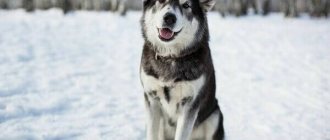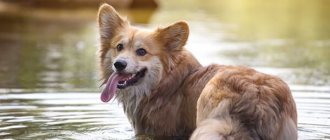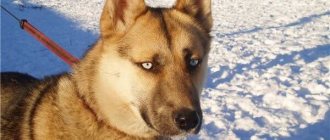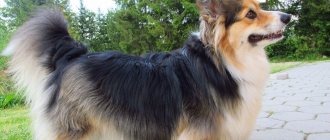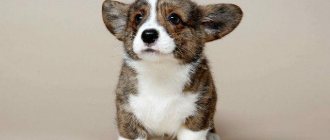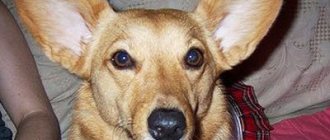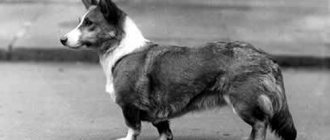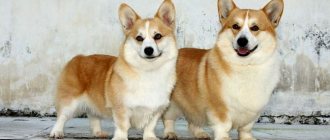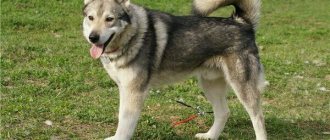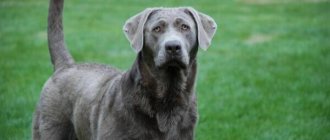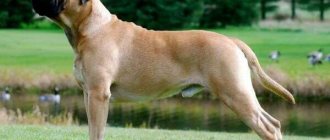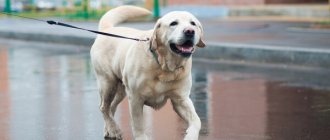The Welsh Corgi is an energetic, active, strong dog.
This is a compact breed of herding shepherd dog.
There are two types of corgis: the Cardigan and the Pembroke.
The first one has round ears and a fluffy long tail.
The ears of the latter are sharper and they have a docked or congenitally short tail.
Description of the breed
A cross between a Welsh Corgi and a Husky is called a Corgi-Husky or a Horgie, the popularity of the new breed is gaining momentum, and the circle of its lovers is growing rapidly.
The mix is distinguished by a long body on short legs, it is small in stature and medium boned. The color is unusually diverse - any combination of white, gray, red and black wool, including mottling, spotting and tricolor.
The Horgi breed is not recognized by the RKF and FCI.
Types of hybrids
From Pembroke Welsh Corgi
Representatives of this species have an elongated body, high-set, large ears and short legs. The coat is short, slightly harsh, depending on whose gene is stronger.
Color ranges from fawn to brown. Less common are individuals of brown or black-brown color.
Height – 22-30 cm, weight – 6-12 kg.
From Welsh Corgi Cardigan
The cross between the Dachshund and the Cardigan Welsh Corgi has gentle paws and an elongated body, a small head, a wide forehead, and high-set ears.
The coat is of medium length, sometimes there are small fringes, the structure of the coat is somewhat rough. Color ranges from chestnut to dark brown with white spots.
Height – from 18 to 30 cm, weight from 8 to 15 kg.
Pet character
The Corgi Husky is a very brave, lively, friendly, playful and resilient dog.
Temperament – sociable, reserved . These dogs explore the world around them with curiosity and interest and are always ready to communicate. They respond well to training.
They love active games, walks and travel. Possessing a gentle character, they rarely exhibit protective qualities.
Not aggressive towards people and other animals (Horgi males can be aggressive towards other males).
Useful video
From the video you will learn about the pros and cons of the Welsh Corgi dog breed:
The Welsh Corgi breed seems to exist only to give animal lovers fits of joy. A small fluffy pet is a complete delight with short legs. But today the Corgi mestizo has become even more famous.
Such an unusual animal can melt the heart of even the most inveterate cynic. However, not all gene mixing options result in an outwardly ideal breed. There are dogs with which it is undesirable to cross corgis for aesthetic reasons.
What it looks like in the photo
The height of the Welsh Corgi and Husky mix is up to 40 cm, weight is 15-18 kg . The dog is of a moderately elongated format, the length of the body is 20-30% greater than the height at the withers.
A head with a narrow, long muzzle, erect pointed ears, a strong neck, a strong back, short legs are the distinctive features of the breed.
The topline is straight, sometimes rising to the base of the tail.
The stance of the forelimbs is straight, parallel, less often barrel-shaped . The coat is thick, of medium length, with a pronounced undercoat, with longer feathering on the hips and underside of the tail.
Corgi Huskies come in solid, bi- and tri-color colors. Often there are dogs with a dark body and light muzzle, paws, and belly.
Eye color - brown, from light to dark, possibly interspersed with blue in the iris, sometimes one or both eyes are blue.
Expert opinion
Kozhevin Semyon Kirillovich
Expert dog handler.
“The temperament of a real shepherd in a small body. From the husky cross there are only fur and ears, the rest is the heritage of the Welsh Corgi. They are well trained, very smart and fidgety. They definitely require upbringing, training, and long-term walking, otherwise they start tearing the apartment apart.”
What did the mestizo take from his parents?
The German Shepherd and Welsh Corgi are breeds with a strong genotype, established selection and minimal tendency to uncontrolled natural mutation. Despite their short stature, short legs and petite build, corgis also belong to the shepherd dog family.
So these two breeds with completely different appearances have very many common properties.
From Corgi
The name Welsh Corgi does not correctly describe the breed in question. One of two more words should be added to it: cardigan or pembroke. Moreover, the Cardigan Welsh Corgi and the Pembroke Welsh Corgi are two different dogs.
The cardigan is older, it has been known since the 10th century. Pembroke was first mentioned three centuries later. The difference lies in the color and size of the tail:
- The cardigan has predominantly dark colors and a long tail.
- The Pembroke is born bobtailed or docked, and the coat is predominantly white and red.
Both Welsh Corgis come from neighboring regions on the Irish Sea (Wales, UK) and can be assumed to be very closely related. These dogs were purposefully bred for shepherding service.
Along the corgi line, the mixed breed took:
- small height (30-45 cm at the withers);
- Pembroke color;
- short hair;
- communication skills and loyal attitude towards people;
- love of life.
One of the negative qualities is a tendency to overeat. Gluttony has become a serious problem for all Welsh Corgis, because of which dog handlers even fear for the future of this breed.
From a German Shepherd
The most famous service dog in the world, whose pedigree also passed on individual traits to the mixed-breed offspring: intelligence, tirelessness, focus on results.
Upon closer inspection, the Corgi and the German Shepherd have such similar personality traits that it is difficult to discern which puppies get the best traits from them. Representatives of both breeds are easy to train and quickly socialize, forming a harmonious four-legged duet with positive properties.
This is interesting! Welsh Corgis became famous thanks to the affection of the English Queen for them. 14 generations of dogs of this breed lived at her court.
Advantages and disadvantages
Positive qualities of horga:
- Cleanliness.
- Learning ability. Dogs have high intelligence and willingly make contact with their owner.
- Not slobbery and practically odorless.
- They can easily withstand frost thanks to their warm fur.
- Excellent companions on active walks.
- Compact size allows you to keep your dog in a small space.
Flaws:
- Due to their active temperament, without long walks, they can become hooligans at home.
- They shed profusely; during shedding they need to be combed to speed up the process of hair loss.
- The long length of the dog can cause problems with the spine. It is necessary to limit jumping and prevent independent descent down stairs at a young age (up to a year).
Varieties of crossbreeds
Mixed corgis are usually good-natured and cheerful animals. They grow up to be ideal dogs, loyal friends, always protecting their owner and all household members. Innate intelligence and agreeableness are integral qualities of such pets. Loud barking is not a habit of hybrids.
Crossing Corgis with other dogs results in the Welsh being overlapping with either breed. Even if one of the parents is completely bald, the hybrid puppy will definitely show the traits of a funny, furry animal with smart eyes. And if the second parent belongs to a large breed of dog, then the result is a mini version of a large dog.
Today there are quite a lot of Corgi crosses with other dog breeds. Some turn out quite successful and look very nice.
Corgi and husky
Husky, crossed with the Corgi breed, is currently becoming increasingly popular among dog breeders. A mixed dog is called a Horgi. The coat color, ear shape and saber-shaped tail are inherited from the Siberian breed.
From an “English” parent – short stature, short legs, body shape and head size. The peculiar sly expression of the muzzle immediately reveals the presence of “British” genes.
Horgs are friendly and obedient by nature. They show restraint towards strangers, but are not aggressive. These are very energetic, brave and hardy animals.
Corgi and dachshund
The Corgi-Dachshund mix first appeared in the British Queen's palace. It was Elizabeth II who crossed her favorite Pembroke with a dachshund and named the breed “Dorgi”.
This mixed breed is small in size, with an elongated body on short legs. The Dorgi is a smart, kind and brave pet by nature. But sometimes he can be cocky, so raising him can be difficult. The dog loves games, adventures and becomes an excellent companion and friend for the whole family.
Life expectancy and health
Horgas have enviable health and longevity; the average life expectancy with good maintenance and care is 12-15 years .
Particular attention should be paid to possible problems with the spine, eyes, skin and coat. It is necessary to limit the diet - Horgi are prone to obesity.
Pug/Chihuahua mix
A cross between a pug and a chihuahua shares similarities with both parents. Larger in size than the “Mexicans” and not as massive as the “Chinese”. The coat color ranges from pale cream to anthracite black, and albinos are occasionally born. The mixed pedigree is indicated by a snub-nosed muzzle, characteristic of natives of the East. The owners dubbed the hybrid dogs chops or chihuaps.
Features of maintenance and care
- Horgis should receive a nutritious diet, but these dogs should not be overfed; they are prone to obesity - owners must control the amount of food they eat. During periods of active growth, in old age, and during intense physical exertion, it is recommended to introduce vitamin and mineral complexes into the Horgi’s diet, aimed at supporting joints, the cardiovascular system, and strengthening the immune system.
- You need to monitor the condition of your teeth. If plaque or tartar appears, the teeth should be cleaned; if this cannot be dealt with at home, you should contact a veterinary clinic.
- It is recommended to deworm your dog once every 3-4 months. The drug is selected taking into account the dog’s weight.
- Horgis must be vaccinated annually with a comprehensive vaccine against major infections and rabies. The vaccine is administered by a veterinarian at the clinic. Self-administration at home is also possible, provided the vaccine is stored in the refrigerator.
- To maintain healthy skin and coat, it is recommended to brush your dog twice a week, and daily during shedding periods.
- Trim nails twice a month. Overgrown claws prevent the dog from walking and can cause paw problems and arthritis.
- Horgas are washed approximately once a month, using a moisturizing shampoo and conditioner. Paws and belly are washed after walks in damp and dirty weather.
It is important to dry the dog completely.
CAREFULLY!
Wet wool can lead to skin irritation, dermatitis, and eczema.
- Corgi-huskies are very active dogs and require long walks. To toilet train a puppy, you need to walk a lot and often, then the process goes quickly.
- Dogs are highly intelligent and easy and fun to train. Dog training can begin with the arrival of a puppy in the house. First of all, they accustom the dog to a name, a place, and a toilet on the street. Basic commands, such as “sit”, “lie down”, “to me”, “near”, “place” - should be taught from 1.5-2 months.
Owner reviews
Natalia:
“I never thought that one day I would get myself a dog. I thought there was a lot of trouble with her - these walks, damaged furniture, constant noise. But my son really asked for a pet, and I couldn’t refuse him. We chose a corgi. Now my life has changed. I love walking and playing with him. You should look for such a sweet and well-mannered dog!”
Irina:
“Do you want a smiling dog? Get a Corgi! Once you look at the photo of this beauty, you will fall in love with her for life. And another plus - thanks to daily walks, the immune system is strengthened and weight is reduced. Totally useful and positive!”
Stanislav:
“After the death of my beloved cat, I flatly refused to have an animal in the house. But luckily, he fell in love with a girl with a corgi. At first I thought: there’s no way there’s a dog in the apartment! But three days after we met, I fell in love with the dog. It’s not difficult to keep her in an apartment, the main thing is to set rules and go for walks regularly.”
Oleg:
“Everyone is delighted with this dog, but I think that she has no place in the apartment. I gave this one to my parents after it chewed all the cords in the house. Parents, by the way, are happy.”
Valeria:
“Corgi makes a good pet... if you have time for it. With my intense work, I couldn’t constantly devote time to her, walk and play. After a while the dog began to feel sad. I had to give it away. And it's not cheap to maintain. As a reminder, there was a pile of wool left on the furniture.”
Feeding the dog
When feeding natural food, it is necessary to take into account all the horga's needs for nutrients and vitamins.
The volume of food is calculated based on the weight and desired condition of the dog..
The daily portion is calculated as follows: for puppies and juniors - 5-7% of weight, for adult dogs - 3-5%.
The diet includes:
- Meat. Beef, chicken, turkey, lean pork. 60% of the daily value during the growth period, 30-40% for adult dogs.
- Porridge. Rice, buckwheat.
- Dairy products. Cottage cheese, kefir, fermented baked milk.
- Vegetables and fruits. Carrots, cucumber, zucchini, pumpkin, apples, pears.
- Vitamin and mineral supplements.
IMPORTANT!
Dogs should not be fed salty, smoked, fried or fatty foods.
When feeding dry food, the owner must monitor the ingredients and quality of the food. Veterinarians recommend feeding dogs with at least premium food.
They contain enough nutrients, meat and offal, vitamins . Your dog should always have clean drinking water.
Important vaccinations
Vaccination of puppies is carried out during the period of 2.5-3 months, when the level of “maternal” antibodies in the blood decreases, which the puppy receives at birth. As long as this passive immunity is in effect, any vaccination will be useless.
After this time, it is necessary to take anthelmintic drugs and get a rabies vaccination.
It is also important to make polyvalent vaccines - they help to avoid many diseases at once, such as canine distemper, parvovirus, viral hepatitis and others.
